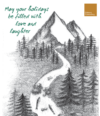This World Wetlands Day, we are highlighting four different types of wetlands, one from each region where we have an Osborn Consulting office.

Larson Lake, Bellevue
About the Wetland: The wetland at Larsen Lake is defined as a bog. Bogs are extremely important to protect since their functions are irreplicable. This is because they take thousands of years to form their ecological and biological functions. Bogs have acidic soils due to the low pH of peat moss that grows here. Due to this unique characteristic, bogs produce biodiversity that other freshwater wetlands cannot.
On-Site Activities: During a nice summer day, extend your walk just a bit further to the Larsen Cabin Trail or Lake Hills Trail to see Lake Larsen and its associated wetlands. While visiting Larsen Lake, bring your fishing gear to try your luck at catching Pomoxis nigromaculatus (black crappie), Oncorhynchus clarkii clarkii (Coastal Cutthroat Trout), Micropterus salmoides (Largemouth bass), or any other of the residential fish species. A U-Pick Blueberry Farm is also open here during the summer months.

Cherry Point Aquatic Reserve, Bellingham
About the Wetlands: Located just 17 miles north of our Bellingham office on the shores of Whatcom County exists Cherry Point. Washington State Department of Natural Resources owns this 3050 acre aquatic reserve, which supports marine and intertidal species such as pacific herring, salmon, orca, eelgrass, and bull kelp. These species are essential to the prosperity of the Salish Sea.
On-Site Activities: Visit the aquatic reserve to check out the local wildlife in the tidepools during low tide. Looking for ways to give back to the community? The Citizen Stewardship Committee is always looking for volunteers to survey intertidal species and marine birds.

UW Union Bay Natural Area, Seattle
About the Wetland: Union Bay Natural Area resides on the northeastern tip of Union Bay, just west of the University of Washington’s main campus. Locals may also know this area as the Montlake Fill. That is because from 1925 until 1966, this area was used as a landfill by the City of Seattle while population growth was booming in the city. It wasn’t until the reorganization and expansion of the Clean Water Act in 1972 that laws required protection of wetland areas. In 1972, the University of Washington took ownership of this landfill and began the conversion of the site to restore a natural wetland ecosystem. The wetland is an example of successful restoration of functions.
On-Site Activities: Walking trails and educational signage exist throughout the park for visitors to learn about the wetland’s history and biological functions. There is a great deal of plant diversity at this wetland due to its expansive 73.5 acres. Union Bay Natural Area is an ideal spot for bird watchers to enjoy their hobby viewing many of the 200 species recorded to be sighted here.

Indian Canyon Natural Area, Spokane
About the Wetlands: The region within Indian Canyon Natural Area contains riverine wetlands, which are naturally used for flood storage. The natural area is located where Hangman Creek and Latah Creek converge with the Spokane River. These wetlands also protect the uplands against channel migration and serves as a biological corridor, which is used as fish spawning habitat.
On-Site Activities: Part of the natural area upstream was converted to a golf course in 1913 before wetlands were federally regulated under the Clean Water Act. This is a wonderful place to cool off during the summer. While visiting, be sure to see the hidden waterfall gem upstream of Latah Creek and look for the monument bestowed telling the story of Chief Spokane Garry.
Celebrating World Wetlands Day
OCI team members volunteered with King County Parks to clean up and remove blackberry bushes at Skyway Park this Saturday in honor of World Wetlands Day. There are three wetlands in the park that function as the headwaters of Taylor Creek, a salmon-bearing stream that passes through Seattle’s Deadhorse Canyon and enters Lake Washington.
Interested in finding your own way to give back to the wetlands in your community? Consider working with local agencies to participate in one of these opportunities:
-
- Host a wetlands cleanup event
-
- Host a riparian planting event
-
- Host a wetland noxious weed removal event
-
- Donate to a wetland conservation organization






